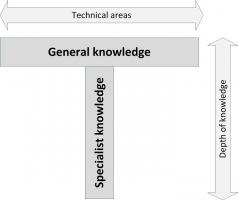Skills of a solution architect architect
Being a solutions architect requires more than a broad technical background. Social skills, management skills and leadership as at least as important.
In general, architects must be able to create a good working relationship with a diverse group of people. Not only project managers, project members, but also business representatives, system managers and enterprise architects. And they need sufficient management skills to manage the technical issues in a project. This includes making decisions on prioritization and handling unforeseen technical issues.
A solution architect must be seen as the technical leader in a project by not only all project members and the project leader (who needs to completely trust the architect on technical topics), but also by the other stakeholders of the project. There must be no uncertainty with senior management, the end users, or the system managers that the solution architect is the person to set the direction of the overall technical solution in a project.
This does not mean that the architect must be a specialist on all technologies used in the project, but he must have enough technical background and experience to be seen as a leader.
In order to perform as a true leader and technical manager I think solution architects should have more than ten years’ experience in IT related functions. This experience is necessary to gain confidence in their own skills, and to have enough technical background to value and create the architecture of a solution.
Experience is typically gained when working in various roles, leading to the architect role. This is why many solution architects have a so-called T- profile.
Figure: T-Profile
This means that they have a broad general knowledge in many technical areas (the top of the T- shape) and one technical area in which they are specialists (the vertical line in the T- shape). This specialism helps them not only in projects using that specific technology, but helps them also to understand technical specialists in general.
In case of an infrastructure architect the specialist knowledge should be infrastructures and the general knowledge should encompass the way the business works, the way applications are used, programming techniques, security procedures, etc.
Preferably, architects have worked for a number of organizations. This way they are used to working in various technical and cultural environments. Working in multiple technical environments helps the architect in understanding why certain solutions work well and others work less well. Also, the way a solution is created can vary from vendor to vendor. Being exposed to solutions built by multiple vendors helps architects value a given solution and help them coming up with new solutions based on earlier experience.
Working in multiple cultures is of much value as well. Working in a banking environment, for instance, is completely different then working in education or working for a production factory. In commercial environments making profit is key, while in the public sector public service is of much more value. Having experienced these differences, architects can be inspired to provide the best solution for most clients.
This entry was posted on Friday 01 March 2013
 English
English